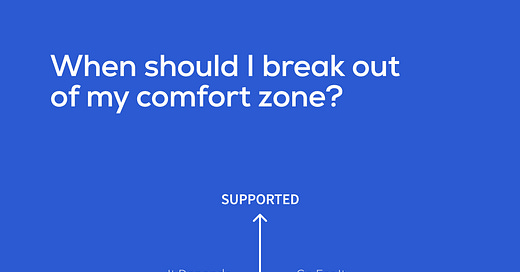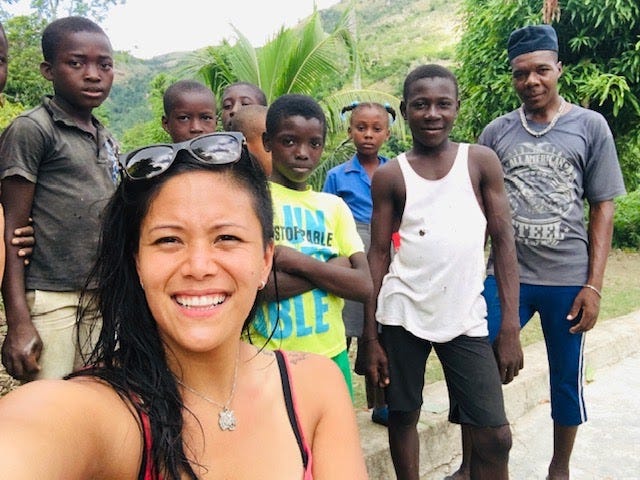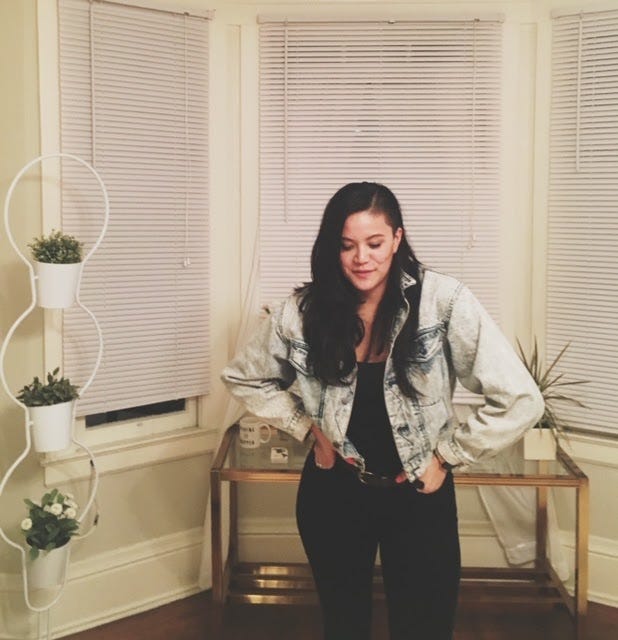In case you missed it, Gridology is coming to your ears! Many of you have reached out saying that there are some weeks where you couldn’t find the time to read Gridology but would love to listen to it instead. Well, I’ve heard you… and soon you will hear me, too.
Fun Fact: The podcast’s theme song is going to be an original piece by Gridology’s very first subscriber. More on that when it drops.
Today, I’m excited to collaborate with another friend and former colleague, Rose Choi Marques. Rose is the global talent brand lead at Squarespace and the founder of Cozo—a startup working to help all of us break out of our comfort zones. She is the perfect person to work with to write today’s post. You’ll see why in a moment.
And now, today’s grid:
It was a scorching hot day in Evanston, Illinois. The sun beamed down onto a sea of purple robes at Northwestern University’s 2015 commencement ceremony. Despite being drenched in sweat and melting in my seat, I heard an insight that’s since defined my post-college experience. As Ginni Rometty, the then CEO of IBM, delivered her commencement address, she shared something profound:
“Growth and comfort do not coexist,” Rometty said.
Simple and accurate. Meaningful and profound. This line stuck with me. As I ventured into “the real world,” I kept Rometty’s words close—it became a mantra of sorts. What were things I haven’t done yet that were exciting, interesting, or new? If I wanted to grow in my personal and professional life, it meant stepping out of my comfort zone.
With that understanding, opportunities started to unlock. I began a new job, moved across the country, dabbled with writing online, and started dating within my first year out of school. I was out of my comfort zone, and the growth I experienced was real. I let my curiosity roam free, and it grew over time. Now, I have a focused list of 12 of my favorite problems. What this list does is help me pursue new experiences that can be potential solutions to any of these questions. I consider my 12 problems my “curiosity sheet.” It’s where I want to learn and direct my focus.
Above all, the list helps me have the curiosity of a 5-year-old rather than an adult who is stuck in his ways. Curiosity is a powerful driver to get me to pursue new adventures, step outside of my comfort zone, and reach into my stretch zone.
However, all that said, comfort zones aren’t something to completely reject. If you want to grow in one aspect of your life, you need to feel supported in others. Comfort zones are safe and needed foundations. While they don’t propel you forward or drive change, they help you feel mentally ready to venture into your stretch zone.
When we are in our stretch zone for long enough, something amazing happens. What was once an area of discomfort or fear becomes safe, normal, and part of our comfort zone. Alex Honnold, the first person to free solo El Capitan (crazy awesome documentary if you haven’t seen it yet), explains this phenomenon best:
“My comfort zone is like a little bubble around me, and I’ve pushed it in different directions and made it bigger and bigger until these objectives that seemed totally crazy eventually fall within the realm of the possible.”
Trying something novel improves our happiness and well-being. Alex is a clear example of this. When we experience new things, dopamine—a neurotransmitter that helps us feel pleasure—is released. Dopamine is powerful. In today’s world, dopamine can be released in ways that hurt us (red notification boxes on our social media apps) and in ways that serve us (trying something new and exciting).
As Mihaly Csikszentmihalyi, the Hungarian-American psychologist who coined the term “flow,” explains:
“The best moments in our lives are not the passive, receptive, relaxing times. The best moments usually occur if a person's body or mind is stretched to its limits in a voluntary effort to accomplish something difficult and worthwhile.”
Science and research tell us that when you activate your curiosity, new neurological connections are made in your brain. We become more intelligent and creative. We feel happier and more fulfilled. Some neuroscientists believe that embracing novelty is the key to staying young and may even be linked to helping prevent degenerative diseases like Parkinson’s and Alzheimer’s.
There are so many experiences we can have that are considered novel. The question is which ones do we choose? This grid will help you negotiate that question.
On the x-axis, we have the level of alignment the new experience has with your values and goals. When we break out of our comfort zone, it’s best to do so for activities that align with where we want to develop.
As we were writing today’s post, Rose and I had different thoughts around bungee jumping. To Rose, the action sport sounds like an exhilarating experience (which she has not yet tried, but wants to) that aligns with her value of seeking more adventure. Not me. I see bungee jumping as one frayed cord away from a devastating newspaper headline. Ensuring stretch zone experiences align with your goals is critical to breaking out of your comfort zone in the most effective way.
On the y-axis, we have how supported you feel in trying the new experience. Trying to do something new by yourself can be more challenging than when others are there to support you (or try it alongside you). While many new activities Rose and I have pursued aligned with our values and goals, when you have the support of others it is a real differentiator. If you can have someone hold your hand while you are in your stretch zone, you are more likely to begin the experience and see it through. The power of human connection cannot be overlooked.
Understanding the Grid
Using this grid can help you identify which new opportunities are worth pursuing, considering, or rejecting. No matter where a new experience lands on the grid, recognize that breaking out of your comfort zone is difficult. It can lead to stress and apprehension. Our hope is this framework can help you better negotiate that right time to take a leap of faith.
Go For It
The new experience aligns with your values and goals, and you are supported in pursuing it. When a new opportunity lands in this quadrant, you should always say yes. These are the types of experiences that turn you into Alex Honnold. As you do more of these experiences, they start to enter your comfort zone. For example, Rose landed in this quadrant when she signed up for her first international service trip with BuildOn three years ago. For Rose, supporting breaking the cycle of poverty, illiteracy, and low expectations through service and education was an important mission she wanted to support. She was also interested in learning more about Haitian history and culture. But a couple of weeks before the trip, Rose learned there were going to be lots of bugs where they were staying… and Rose has a serious fear of insects (entomophobia). She was about to pull out of the trip when the BuildOn liaison called her to understand her fears, and ultimately remind her why she had signed up in the first place: to build a school, help the children in the community, and learn more about the culture. After that conversation, Rose was convinced. She decided to go on the trip. She loved it, and she’s since been on two more service trips to Senegal and Nepal.
Rose on her first BuildOn trip to Haiti.
I, too, have been in this quadrant. When I first joined the high school newspaper I wanted to quit after writing my first article (look at me now haha). However, I didn’t do that. My parents had supported me, helping to get back into the newsroom. They realigned me, helping me to remember why I got involved in the first place: that I loved to write and that joining the paper would help me get better at it. So, I stuck with it. I wrote for the high school paper for four years, became managing editor, and even went to journalism school.
Try It
The new experience aligns with your values and goals, but you are alone in pursuing it. When an activity lands in this quadrant, pursuing it can feel a bit more like taking a leap of faith. You feel anchored on why you should do something new, but taking that final step to do it is extra tough because you’re going at it alone. About four years ago, Rose had an itch to do something different. She wanted to shave the side of her head. To her, it was just hair. It would grow back if she didn’t like the way it looked. To her friends, she heard responses like, “Oohhh that would look a little crazy.” She was alone in pursuing something that would help her be uniquely her. However, she didn’t let the lack of support stop her. She went for it.
Rose rocking her fresh haircut.
Hemming and hawing these decisions don’t help—they only hurt you here. The more you assess the pros and cons of if something will work or not work, the more time you waste. It’s better to try, fail, and adjust than it is to never try in the first place, and later wonder what could have been. This speaks to Jeff Bezos’s regret minimization framework I shared a few weeks ago. That’s what I did when I moved to San Francisco. I received a fantastic opportunity to start my career at LinkedIn, but it was on the West Coast. While I was worried about how much I’d like living in SF, I just went for it (despite my parents and friends being sad I was moving 3,000 miles away). In the end, this turned out to be only a seven-month experiment. I tried the West Coast and didn’t love it… and that was okay. My time in SF was valuable nonetheless. When you’re in the Try It quadrant, you’re optimizing for learning. Trying something and having it work out is just as valuable as trying something and having it not work out.
It Depends
The new experience does not align with your values and goals, but you are supported in pursuing it. Experiences in this quadrant could go either way. Whether you pursue them depends on what else is going on with your life. If you have loads of free time and are searching for something new to do, why not try an experience that lands in this quadrant? If the activity doesn’t align with your goals, and you have other experiences that you’re eager to try out (such as those in the Try It or Go For It quadrants), it doesn’t matter how popular it may be with your network. You shouldn’t pursue it. For Rose, this meant not learning the guitar. Despite both her dad and brother being guitarists, learning how to play never became a real goal for Rose. She’s instead focused on her queue of new activities that are more aligned to her values and interests. Maybe that changes in the future, but for now Rose is content listening to others play the guitar rather than playing herself. When you say yes to experiences in this quadrant, you’re primarily exploring your curiosity. Try to lean into supported activities that push you to grow—they are the toughest ones to try but they can be the most rewarding. For example, this is how I got into cycling. A few years ago, I had a few buddies who wanted me to go to a spin class with them. I’d never taken a spin class before and was initially resistant. I begrudgingly went and the class destroyed me (in the best way). It was one of the best workouts I had in a while. It created a real habit, and now cycling is a form of cardio I actively seek out and enjoy.
Not Now
The new experience does not align with your values and goals, and you are alone in pursuing it. Here, the answer should be no, for now. Experiences that land here should only be considered if you feel more supported or if you change your values or goals. Personally, this is where writing a screenplay lands. I’ve had this as an item on my bucket list for years, but have never been able to take the leap and start writing. While an interest, it’s not a real priority for me right now—I have a full-time job, a new puppy, a wedding to plan, a newsletter to write, a podcast (coming soon) to record, and a life to live. Plus, I feel alone in pursuing it. I don’t have anyone to collaborate with and no one (friends nor family) is telling me to go for it. It’s dead in the water. For Rose, this is where running a marathon or triathlon lands. While Rose loves fitness, she likes working out on her own terms. She doesn’t value the competitive aspect of racing. Maybe that changes in the future, but for now, she is content exercising on her own terms.
Grid Shortcomings
This grid can do a better job of capturing the fact that no matter what quadrant your activity lands in, stepping out of your comfort zone can be scary and challenging. Leaving your comfort zone means something different for everyone. For me, it generates feelings of fear, self-doubt, and anger (that I actually signed up to do the experience). I get a sinking feeling in my stomach—the same feeling you get if you think you left the stove on. Knowing how stepping out of your comfort zone makes you feel can help you embrace it as potential energy rather than anxiety.
This grid fails to mention the danger zone—a threshold where trying new things doesn’t cause you to grow but rather causes debilitating stress. Some anxiety when stepping outside of your comfort zone is necessary but only up to a point. Once it interferes with your ability to properly function, you’ve gone too far. Breaking out of your comfort zone should be done with baby steps, not giant leaps.
Comfort zones make our world smaller. Leaving them makes us better. We hope this grid can help you conquer your fears in trying something new. As we get older, it becomes more difficult to try new things. Stay curious. Stimulate your mind. Push your body and spirit to new limits. Embrace new experiences that align with your values and goals. Lean into your support network. Listen and keep an open mind. Squash your inner turmoil by taking intelligent risks. Breaking out of your comfort zone is like a muscle—the more you do it, the easier it gets.
Life’s only as confusing as you let it be,
Ross & Rose
If you enjoyed today’s Gridology post, please consider forwarding it to your friends, family, or colleagues. As always, please reply to this note or find me on Twitter if you have any feedback, have ideas for a post, or want to collaborate. You can find more of Rose and the work she is doing around getting out of your comfort zone at Cozo.






